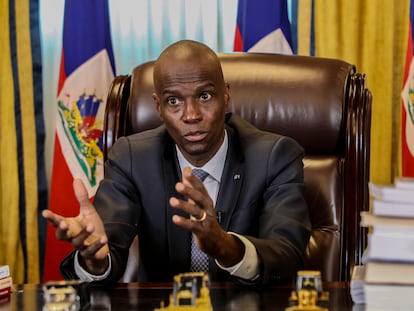Haitian migrants risking their lives on Darién jungle route
The authorities do not know how many people have died trying to cross the pass separating Colombia from Panama to head north to the United States. After years of tragedy, they are considering how to make this migration route safer
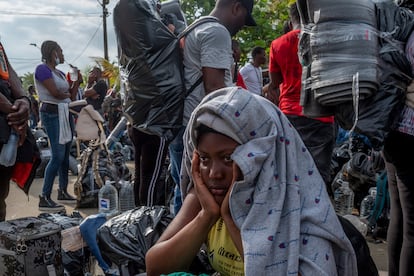

“Salomon died this week in the jungle,” says Jeff Sagasse, uttering the phrase with resignation, as if speaking of an inevitability. Sagasse is Haitian, as was Salomon, and he is sitting in a restaurant in Necoclí, a coastal town in Colombia where more than 10,000 migrants have crowded together to cross into Panama.
Sagasse pulls out his cellphone and shows EL PAÍS a picture. It’s Salomon, a man wearing a wide-brimmed red hat and looking into the camera. His first name was Raymond. In the photo, a cross is drawn above him and a message written in Creole: “It is with great sorrow that I learned of this news. Rest in peace my friend.” They say he was 42 years old and a builder, and that he tried to cross the impenetrable Darién jungle with eight family members. He drowned in a river, as no one was able to help him. “Salomon was an excellent construction worker, and before going I told him to take care of himself. But he left us,” says Irvens Norvilus, another Haitian who was about to travel to the Darién zone from Chile.

The authorities do not know for sure how many migrants have died trying to reach Panama, just one step in the long journey through Costa Rica and Mexico with the final aim of reaching the United States. Those who have crossed are clear that the 500,000-hectare Darién Gap is one of the most dangerous in South America. This thick and humid jungle, they say, is a cemetery.
The dangers come from all sides and the Haitians know it, but some feel they have no choice. “Yesterday I cried, I called my family, but my sister told me: do anything but turn back, you’ve come this far, so keep going,” says Surys Rivera, a Dominican who was traveling with a group of Haitians. She picks up a bottle of creolin, a disinfectant that supposedly repels snakes and other animals in the jungle. Her suitcase contains three inhalers because she is asthmatic, along with pain pills and some clothes. Her departure point was Chile, before crossing Peru, Ecuador and Colombia. She leaves her cellphone number to talk about the journey, but after she waves goodbye, there is no more news from her. Here, migration is a WhatsApp message with a single tick, which may or may not ever be answered.

The Necoclí dock is bustling. As on many days since July, thousands of Haitian men and women with children in their arms are lining up to board a boat and leave this coastal town of 70,000 inhabitants (20,000 in the urban area) to head to Capurganá, the last town before entering the Darién jungle. The beats of African and Colombian music blend together over loudspeakers, as a vendor reads the names of the migrants who have managed to get a place on a boat over a megaphone. He asks them all to put on face masks, but no one listens. The humidity is suffocating. A Haitian couple carrying a baby do not manage to get on the boat. They have come from Brazil and do not speak Spanish. They could not buy a ticket to travel with an accredited company, so will have to wait for another day or venture out on an illegal boat. Distress is evident in their eyes, but they stay silent.
Villa Haiti is the name given to this area where about a thousand people a day crowd together to leave on legal boats. A few blocks away, another large group of Haitians tries to obtain their own spots. According to the Panamanian authorities, 18,000 migrants entered Panama in July alone. The Haitians are organized into groups of families or friends, and support each other through the jungle crossing. A day before each trip they send a leader to buy the boat tickets, but they do not always get enough for everyone, breaking up these small support groups. “All children over two years old have to pay. We need to get 92 people in and there are 94. The only option is for one person in the group to get off,” says a Colombian who organizes the boat trips. “It’s humanitarian aid, but it’s also business.”
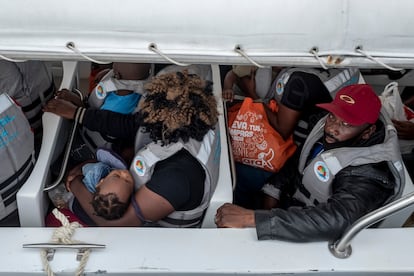
The migrants pay $55 (€47) for a trip to Capurganá, and for that, they will have a life jacket and good travel conditions. Their suitcases are protected from the water and marked with their names, but the ticket costs a little more than double what a visiting tourist would pay. In Necoclí, the risk of a migrant’s life is calculated in dollars, and their hard currency has revived this town’s economy. The more money, the less risk, they are told.
Those who have more money and fear the jungle prefer to pay for illegal boats, which leave on dark and windy nights. They pay up to $450 (€386) per person for the smugglers to take them directly to Panama by sea. That way they avoid eight days of dangerous paths and potential robberies, says a local source. “Sadly, people believe the worst problem is the wild animals, but the greatest danger is the criminals who violate the rights of others,” confirms Juan Francisco Espinosa, the director of Migration Colombia, a government body.
The sea that swallows migrants
Avoiding the jungle does not always mean avoiding danger. The sea also swallows migrants. In January of this year, a boat carrying Haitians was shipwrecked in Pinorroa Bay, on the Colombian side. Three bodies were found, including that of a six-year-old girl, but four other migrants are still missing. Earlier in 2019, 21 others died, a one-year-old baby among them. “With it being irregular migration, the deaths are hidden. The same happens in the Darién Gap,” says Espinosa.

All the migrants pay “guides” who charge them $120 (€102) each and offer them security against the presence of armed groups such as the Clan del Golfo. “I ask people who are thinking of coming not to do so, don’t come, because there are many dangers in the jungle. They took my belongings but left me with my life. The guides left us stranded on the second day,” says a Venezuelan who crossed the Darién. Robbery, rape and murder are all risks, according to several testimonies that circulate on the beaches of Necoclí.
Pandemic effect
The humanitarian crisis is not new, but has been exacerbated considerably by the coronavirus pandemic. After Haiti’s devastating 2010 earthquake, many people migrated to Brazil and Chile. But the economic effects of lockdown in those countries have forced them to cross an entire continent. “I had a nightclub that closed with the lockdown,” says Sagasse. Dressed like a basketball player, he says he would like to talk to Iván Duque, the president of Colombia. “We need proper transportation, a humanitarian passage to Panama. We don’t want to stay in Colombia, we just want to pass through and continue on to the United States or Canada.”
Transitory migration nevertheless has a strong impact. In 2016, there were 34,000 migrants transiting, which dropped to just 4,000 in 2020, according to Migration Colombia. The new wave is rapidly making up the backlog, says Espinosa.
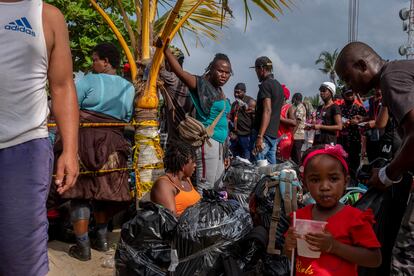
The gathering of so many migrants in Necoclí has also been labeled a health crisis. The children, says a doctor from the municipal hospital that provides free care on the beach, usually have diarrhea, while the adults have the flu. Nearby, the Family Welfare Institute delivers nutritional supplements to pregnant women and children, but the aid stops there. Little is said about the coronavirus.
Rumors circulate and the migrants cling to the slightest certainty: a picture, or an audio message from someone who reached the other side of the border. They ask about the possibility of a humanitarian crossing. “Is it true that they only do that for Cubans and Venezuelans?” asks Julio Chacón, a Cuban who left through Suriname, arrived in Venezuela, went on to Colombia and now works as a waiter to pay for his passage in the jungle.
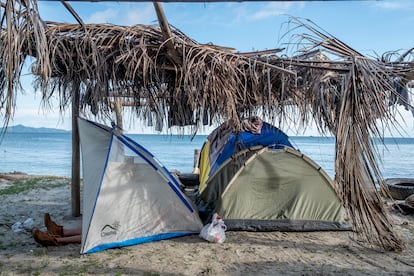
A group of Venezuelans who arrived on foot to Necoclí live in tents on the beach. They are led by Saida González, a Venezuelan military veteran who cries every time she talks about her uniform. Her group also begs for a corridor that will allow them to reach Panama safely. “We know about the rapes, robberies and deaths in the jungle,” she says, mentioning videos from compatriots showing corpses.
The Colombian and Panamanian authorities say they have decided to explore humanitarian corridors, The Panamanian Foreign Minister Érika Mouynes will visit the Colombian side where the migrants gather to determine a quota that can be received in an orderly and safe manner. “We do not want migrants to risk drowning or for them to go through the Darién, which is so risky. There are so many children and women,” says Colombian Foreign Minister Marta Lucía Ramírez.
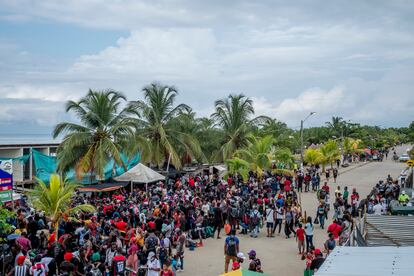
For Salomon, or the baby from the Democratic Republic of Congo who died in 2019, it is too late. While these decisions become realities, the flow of migrants does not stop. Guerlande Lesperance was 21 years old when she spoke to EL PAÍS, and she didn’t know how to swim. Days before embarking on a voyage that would take her directly to Panama, she was struck by the fear of drowning, and that her family would see her sink and no one could do anything about it. “There are many people who died in the water, I wouldn’t want to see that,” she said. Like many others, she left her cellphone number behind, but she still hasn’t answered.
Tu suscripción se está usando en otro dispositivo
¿Quieres añadir otro usuario a tu suscripción?
Si continúas leyendo en este dispositivo, no se podrá leer en el otro.
FlechaTu suscripción se está usando en otro dispositivo y solo puedes acceder a EL PAÍS desde un dispositivo a la vez.
Si quieres compartir tu cuenta, cambia tu suscripción a la modalidad Premium, así podrás añadir otro usuario. Cada uno accederá con su propia cuenta de email, lo que os permitirá personalizar vuestra experiencia en EL PAÍS.
¿Tienes una suscripción de empresa? Accede aquí para contratar más cuentas.
En el caso de no saber quién está usando tu cuenta, te recomendamos cambiar tu contraseña aquí.
Si decides continuar compartiendo tu cuenta, este mensaje se mostrará en tu dispositivo y en el de la otra persona que está usando tu cuenta de forma indefinida, afectando a tu experiencia de lectura. Puedes consultar aquí los términos y condiciones de la suscripción digital.
More information
Archived In
Últimas noticias
A survivor’s account of the Interoceanic Train accident: ‘We were scared because of the speed on the curve’
The Interoceanic Train, the Mexican alternative to the Panama Canal
What is known about the Interoceanic Train derailment in Oaxaca
Trump turns a Minnesota fraud allegation into ammunition for his MAGA army against Democrats
Most viewed
- Oona Chaplin: ‘I told James Cameron that I was living in a treehouse and starting a permaculture project with a friend’
- Reinhard Genzel, Nobel laureate in physics: ‘One-minute videos will never give you the truth’
- Why the price of coffee has skyrocketed: from Brazilian plantations to specialty coffee houses
- Pablo Escobar’s hippos: A serious environmental problem, 40 years on
- Chevy Chase, the beloved comedian who was a monster off camera: ‘Not everyone hated him, just the people who’ve worked with him’
